The fastest way to turn off the screen in Windows
Neither Windows 10 nor Windows 11 provide a convenient keyboard shortcut to turn off the screen. Depending on your settings, it may take a few minutes or a few hours until your screen turns off automatically. The following article will show you the easiest ways to control the screen and turn it off whenever you want. This not only helps you save energy, but also prevents screen burn-in and long-term damage.
1. Turn off the screen using hotkey on the laptop
Although Windows doesn't include keyboard shortcuts, your laptop may come with a hotkey to turn off the screen. This varies depending on the manufacturer and laptop model. Check the top row of keys, usually the F1-12 keys, for the screen off icon and try it out. You may have to hold down the Fn key (usually bottom left) to override the F key and activate the hotkey function.
2. Update Windows power management settings
Windows provides many power management settings. Let's see how you can use these to control when your screen turns on and off.
How to turn off the screen automatically in Windows 11
To turn off the Windows 11 screen, go to Start > Settings > System > Power > Screen and sleep and select your preferred timeout.
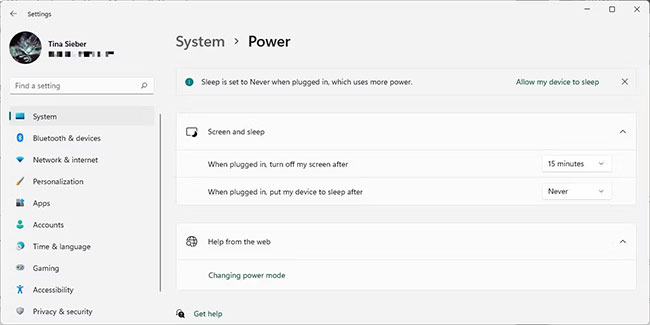 The fastest way to turn off the screen in Windows Picture 1
The fastest way to turn off the screen in Windows Picture 1
Note that this setting will not affect games or video-based media content, as these settings will keep your screen on. This means you can continue watching movies or shows without worrying about the screen turning off, even when the screen off time is set to just a few minutes.
How to make the screen turn off automatically in Windows 10
To control how quickly your screen turns off, go to Start > Settings > System > Power & sleep and customize the time under the Screen heading. If using battery, the article recommends turning off the screen after 5 minutes or less. When plugged in, you can leave it on a little longer, but 10 or 15 minutes max.
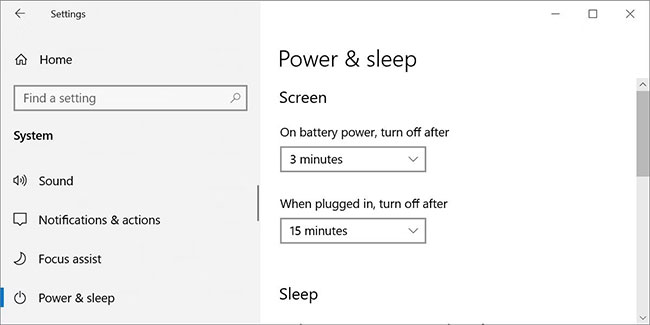 The fastest way to turn off the screen in Windows Picture 2
The fastest way to turn off the screen in Windows Picture 2
How to turn off the screen using the power button
To manually turn off your screen with the click of a button, go to Control Panel and use the power button on Windows again to turn off your screen. This works on both laptops and desktops and will save you more energy than letting Windows automatically turn off the screen after being inactive for a few minutes.
In Windows 10, go to Start > Settings > System > Power & sleep > Related settings and click Additional power settings . This will take you to the old Windows Control Panel.
In Windows 11, you will have to manually navigate to Control Panel. Press Windows key + Q , search for Control Panel and open the corresponding result. In the top right corner of Control Panel, make sure View by: Large icons or View by: Small icons is selected , then select Power Options. In the left pane, click Choose what the power button does.
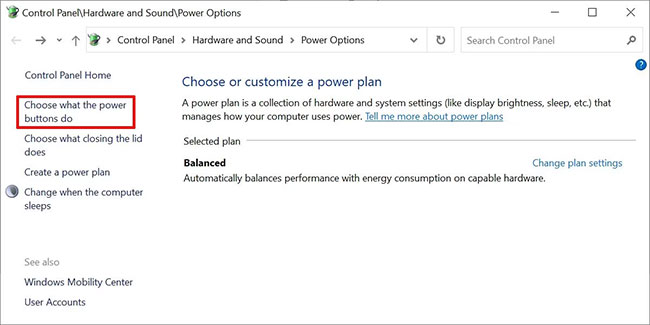 The fastest way to turn off the screen in Windows Picture 3
The fastest way to turn off the screen in Windows Picture 3
In the next window, under When I press the power button , you can turn off the screen while on battery or plugged in. (If you don't see that option, check below). Click Save changes to lock in your preferences.
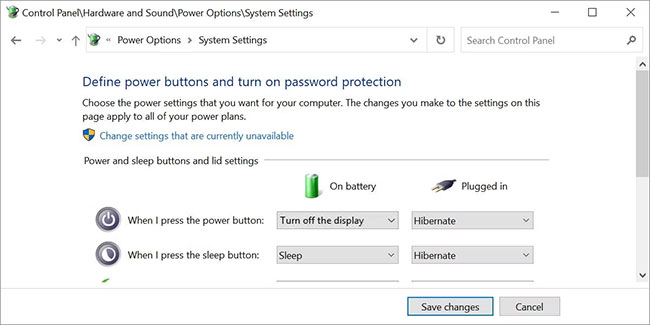 The fastest way to turn off the screen in Windows Picture 4
The fastest way to turn off the screen in Windows Picture 4
When this setting is enabled, all you have to do to turn off the Windows screen is press the power button. Note that you can still forcefully shut down your computer (in case it's locked) by holding down the power button for a few seconds.
The best tools to turn off the screen on Windows
Maybe you don't want to manually turn off your PC screen or don't want to change the power button's default settings. You can use a third-party tool to turn off your screen. Here are the 4 best options.
1. Turn Off Monitor
Turn Off Monitor is a small executable utility that does just one thing: Turn off your screen. You don't need to install it. Just download the file, extract the ZIP file, store the widget on your desktop and double-click whenever needed. You can specify a keyboard shortcut to run the utility.
If you see a security warning, you can bypass it by removing the check mark next to Always ask before opening this file .
Note that in Windows 10, when you use this widget and are ready to continue working, the screen will return to the lock screen. If you don't want to enter your login information every time you turn off the screen, you can turn off the lock screen. However, that means anyone can access your screen when you're not around.
2. Turn Off Screen
 The fastest way to turn off the screen in Windows Picture 5
The fastest way to turn off the screen in Windows Picture 5
Someone at Microsoft must have realized how cool it is to have a shortcut to turn off the screen because they wrote a script for it. You can now find it on GitHub.
Save the ZIP file, extract it, find the BAT file inside and double-click to run it. You can even change the icon and assign shortcuts for which you can find instructions below.
3. BlackTop
Don't want to assign keyboard shortcuts manually? BlackTop has its own feature: Ctrl+Alt+B. Unfortunately, you cannot change the key combination.
Note that this utility requires Windows .NET Framework 3.5 feature. If you do not have the correct version of the .NET Framework installed, Windows will offer to download and install it after you complete the installation. Installing the .NET Framework may take a while.
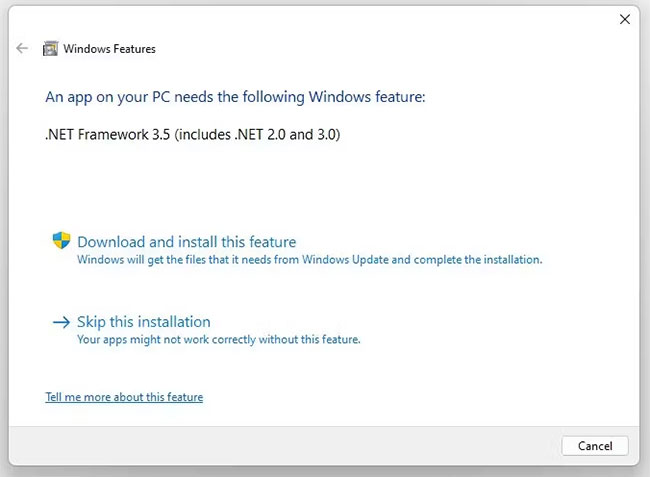 The fastest way to turn off the screen in Windows Picture 6
The fastest way to turn off the screen in Windows Picture 6
4. NirCmd
NirCmd is a command-line utility that can complete a variety of tasks, including turning off your screen. You can run NirCmd without installation. However, if you want to use it regularly, it is more convenient to install it and not have to enter the full path every time you want to run a command.
To install NirCmd in Windows 10, extract the ZIP file, right-click nircmd.exe and select Run as administrator . Next, click the Copy To Windows Directory button . Confirm with Yes in the following window. After the operation is completed, click OK in the previous window.
 The fastest way to turn off the screen in Windows Picture 7
The fastest way to turn off the screen in Windows Picture 7
Now that you have NirCmd installed, you can use it to turn off the screen and complete other tasks. Admittedly, opening the command line and typing a command every time you want to turn off the screen is probably the most inconvenient solution. However, you only have to do it once to create the shortcut, then you can assign a hotkey to it.
Press Win + R to open the Run utility, then enter cmd and press OK.
In the command line, type the following command:
nircmd.exe cmdshortcutkey "c:temp" "Turn Monitor Off" monitor offPress Enter to run the command.
If you did not copy nircmd.exe to Windows Directory, enter the full path. Instead of "c:temp" , you can choose any other location for the shortcut file. "Turn Monitor Off" will be the name of the shortcut file, but you can choose another name.
3. How to assign hotkeys to run any tool
This works for any executable, including the tools above. First, right-click on the EXE file and select Create shortcut. Note that you have already created a shortcut for NirCmd if you followed the steps above.
Next, right-click on the shortcut file and select Properties. Place your mouse in the Shortcut key: field that says "None" and click your keyboard shortcut, such as Ctrl+Alt+J. Click OK to confirm.
 The fastest way to turn off the screen in Windows Picture 8
The fastest way to turn off the screen in Windows Picture 8
Finally, test your shortcut and enjoy the convenient experience it brings!
Wishing you success and please read more great tips on the QuanTriMang page.
You should read it
- Instructions to turn off ads on the Screen Lock screen Windows 10
- How to set a timer to turn off the Windows 11 PC screen
- 7 ways to turn off Windows 10 laptop screen
- How to turn on the search box on the lock screen on Windows 10
- How to turn off Screen Time on iPhone and Mac
- Steps to fix Windows computer screen not turning off after set time
- How to turn off your Android phone screen using the Smart Screen On Off application
- How to keep the computer screen on
- Fix the problem that the PC turns on but doesn't turn on the screen
- Automatically turn on / off the phone screen without power button
- How to turn off the Lockscreen lock screen on Windows 10
- How to turn off the lock screen on Windows 10 Creators Update
May be interested

Basic Linux commands everyone needs to know - Operations on Linux are much faster

How to fix error 0x80070422 in Windows 10, fix error 0x80070422 update Windows

How to get admin rights on Windows

What is Pentest? Learn about Penetration Testing (penetration testing)

How to Active Windows 11, using FREE copyrighted Windows

How to use the ipconfig command to refresh and reset IP address





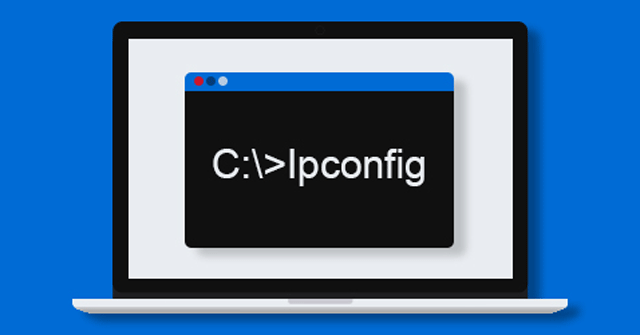
 Instructions to turn off ads on the Screen Lock screen Windows 10
Instructions to turn off ads on the Screen Lock screen Windows 10 How to set a timer to turn off the Windows 11 PC screen
How to set a timer to turn off the Windows 11 PC screen The fastest way to adjust screen off time in Windows 7/8/8.1/10
The fastest way to adjust screen off time in Windows 7/8/8.1/10 How to turn off Start Screen on Office 15 for Mac fastest
How to turn off Start Screen on Office 15 for Mac fastest 7 ways to turn off Windows 10 laptop screen
7 ways to turn off Windows 10 laptop screen Steps to fix Windows computer screen not turning off after set time
Steps to fix Windows computer screen not turning off after set time